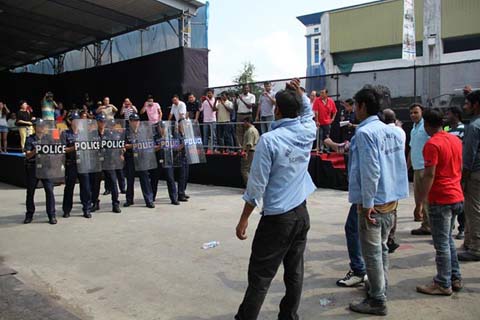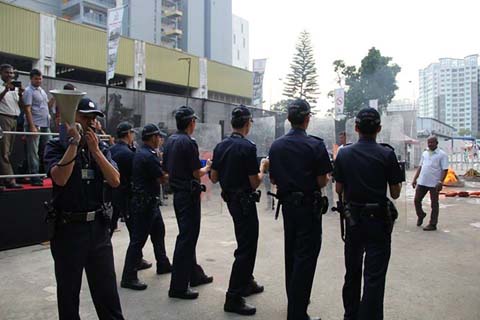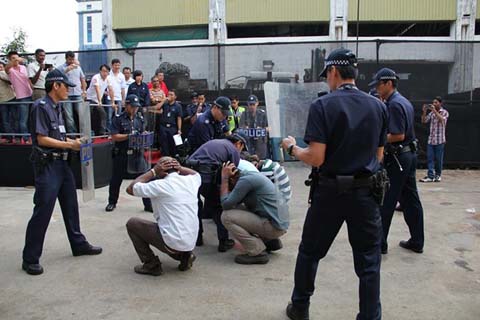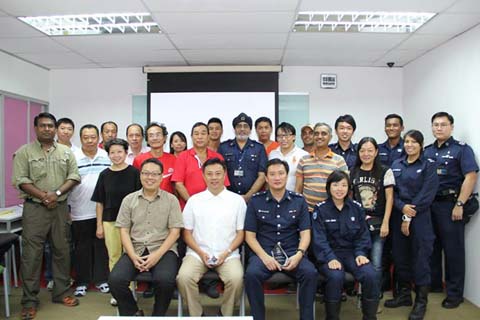
The recent controversy about a ‘riot control exercise’ reveals a blind spot among ministers and not a few decision-makers and ‘grassroots’ surrounding them. They seem unable to see a point of view that is emerging in Singapore: what I would call the ‘Post-independence generation’ outlook. This outlook is subtly but importantly different from that of the People’s Action Party and its devout followers in terms of how they see race and nationality in our society. PAP et al see race and nationality as a reality we have to accept and work with, but the new outlook puts a moral (dis)value on such distinctions and want us to actively avoid using them.
Additionally, a closer examination of the photographs and the words articulated by Khaw and others reveals something more: a government (and its courtiers) engaging shamelessly in doublespeak.

Let me deal with the doublespeak part before I come back to explain what I mean by ‘outlook’ differences.
For the record, below is the Facebook post put out by National Development Minister Khaw Boon Wan on 11 November 2014. Some words have been put into bold by me; I will comment on them further down.
Joint exercise with Police, SCDF & foreign worker ambassadors (8 photos)
We have a few foreign workers’ dormitories. What if some quarrels erupt, leading to fights or worse? These are possible scenarios, given the concentration of foreign workers in one locality. Little India riot was an extreme case, but minor scale fights could happen locally. To test our response capability, the Police, the [Singapore Civil Defence Force], the dorms operators and our grassroots organisations organised a simulation exercise recently. It was a useful way to network up the various agencies, and spread preventive messages. Prevention is always better than cure.
When the post began attracting critical comments, Khaw added a day later:
The exercise was conducted two weeks ago in a dormitory located within Sembawang. I was then in Suzhou for the Suzhou Industrial Park celebration. My grassroots leaders who helped organise the exercise reported to me yesterday that the exercise went well and was well received by the various stakeholders: grassroots, SPF, SCDF and foreign workers ambassadors who worked hand in hand on the exercise. They found it to be a meaningful collaboration which bonded the residents and foreign workers. In fact, a buffet lunch was also organised for all who participated to celebrate the successful conclusion of the exercise. This is one of the many engagement and education sessions conducted by our grassroots and government agencies with foreign workers, regardless of nationality or race. Past efforts cover areas such as first aid, dengue prevention and local culture. Our intent is to promote mutual understanding with the local community.
There are so many things wrong with the above, not least the vacuousness of boilerplate expressions, I hardly know where to begin. But let’s deal with the small things first.

Calling the workers involved “foreign worker ambassadors” suggests that they willingly volunteered for the part. However, on 13 November, the Straits Times quoted the workers’ manager as saying he selected (and presumably ordered) them to do as told.
Organisers from Wee Chwee Huat Scaffolding and Construction Company, which owns the dormitory, were shocked by the reaction. The firm’s operations manager, Mr V. Manimaran, told The Straits Times they invited Woodlands grassroots leaders who shared pictures with Mr Khaw.
“We are not racist,” he said. “About 10 workers were involved, both Bangladeshi and Indian nationals. We chose them as they make up almost all of the workers employed by our company.”
— Straits Times, 13 Nov 2014, Anti-riot drill meaningful, says Khaw
That smashes one boilerplate expression. The men were told to present themselves for target practice. “Ambassadors” they were not.

Secondly, Manimaran confirmed what the photos seemed to indicate. There were only ten foreign workers taking part in the exercise, confronted by perhaps ten or twelve officers. This is a very small group, so small that one inevitably asks: What can be learned from it? Moreover, the pictures reveal a very confined space, with observers and journalists standing just two or three metres away. And most astounding of all, it had been scripted!
The event was organised with the Woodlands and Marsiling Industrial Association, which brings together business owners and dormitory operators in the area.
The workers acted according to a script in which they went on strike over living conditions.
Mr Manimaran said: “I am Indian and I wrote the script. I did not find it racist.”
— ibid.
|
It should be clear by now: it was never meant as a training exercise for the police. As Khaw and his henchmen talked out of both sides of their mouths, they revealed the true intent of the ‘simulation’. It was meant to instruct workers to behave, akin to obedience school for dogs.
Dormitory Association of Singapore president Kelvin Teo said such role plays are done regularly in various dormitories. The actors are usually senior workers who help to spread the message about the consequences of rioting.
“We get workers to act because it is more realistic that way. They volunteer to help us too,” he said.
— ibid.
Ah yes, more of that “volunteer” word.
As for “realistic”, who is kidding who? In any case, Khaw himself had used phrases such as “spread preventive measures” and “education sessions”. So now we know: it was actually third-rate propaganda theatre aimed to intimidate the migrant worker population, though how that would “promote mutual understanding” and “meaningful collaboration” (Khaw’s words) was left unexplained.
Well, maybe the kind of understanding trained dogs acquire: Who is master and who is dog.

At the end of the exercise, they posed for a group picture. I can’t spot any foreign worker “ambassador” included in the honorary line-up.
* * * * *
I don’t think the true intent of the exercise was immediately apparent during the controversy. As you can see from the above, it takes some reading between the lines to tease it out.
Instead, the tsunami of criticism that crashed onto Khaw came from something a lot more kneejerk. Significant numbers of Singaporeans just feel it to be wrong to single out any group by race or nationality in a way that casts aspersions on them. This is a morally illegitimate approach, they were saying. It indicates a much more acute sensitivity in the post-independence generation to using race and nationality categorisation thoughtlessly. It may also indicate a resistance to drawing a distinction between migrant workers and ourselves, such that targetting migrant workers in this way struck them as unacceptable.
Khaw, the organisers of the ‘exercise’, his ‘grassroots’ and other ‘stakeholders’ — in other words, the satellites that slavishly orbit PAP power centres — clearly had no clue that this is how many Singaporeans now think. They were surprised that empathy and solidarity can cross race and nationality boundaries. In that sense, they are still stuck in an age where Singapore is seen as an uneven collection of racial boxes.
|
They are also unable to spot (and avoid) situations when prejudicial associations are being made for a target group. In the old days, such associations would be the order of the day. Nobody would think twice. But the post-independence generation may be a lot more alert to it.
Khaw himself argued (in his second post) that having foreign workers involved in a simulation exercise is nothing new. “Past efforts cover areas such as first aid, dengue prevention and local culture,” he wrote. He sounded bewildered that people singled out this riot control exercise for criticism. Others, coming to his defence on Facebook, asked why anyone was upset about this incident when they would not be with, say, fire drill exercises held in schools involving schoolchildren as a selected group.
The difference is that such scenarios — accidents needing first aid, dengue prevention and fire safety — do not bring with them implications of wrong-doing or anti-social tendencies. Megaphoning a riot suppression message to a particular group does. It is worse when that group is defined along race or nationality lines.
Moreover, in publicising with evident pride this exercise, Khaw was probably assuming that people in general agreed with him that riot control amongst foreign workers was an important and necessary objective. It perhaps springs from the high priority that PAP minds place on internal security. One can discern another perception gap here. Singaporeans don’t see the (small) risk of riots in such an apocalyptic way. The don’t share the siege mentality that characterises PAP’s worldview. And especially as they don’t see any need for alarm, the singling out of foreign workers for this exercise appeared completely unwarranted.
This failing on the part of our ministers is part of a broader pattern. They are increasingly out of step with how more and more Singaporeans think and feel. The Singapore that they know and consider normative is different from the Singapore that a new generation aspires to, and yet they’re not even aware of the gap. This lack of an intuitive feel for a new Singapore is going to lead to more such public relations blunders.


In the old days we used to have IS Exercises every 2 years where the whole SPF and even SAF were involved. Large scale riotings everywhere were organized for the Div police and Riot Squad police to tackle.
I took part in quite a few of them.
Whatever happened to them? IS exercises were stopped since 1986.
Methinks the G did not want to scare away tourists and investors.
We should have them back to test the mettle of our SPF and iron out creases and uncertainties esp in communication and command and control.
No wonder the Little India riots in 2013 left the SPF in tatters with the local commander and his Div men running around like keystone cops.
None of the current scholar commanders, even the CP and DCP ever experienced a single IS Exercise! They were thus left flat-footed on 8 Dec
2013.
I think Khaw would readily see the point if someone were to suggest to him to conduct a similar simulation exercise using PRC workers. The Chinese, after all, were responsible for the first illegal strike action in 50 years! He would shrink from such an idea given the current big brother stature of China. Furthermore, PRC nationals are assertive and not easily intimidated people.
Khaw and by implication the govt are guilty of ‘racial profiling’ the south Indian workers. Funny thing is we don’t hear even a whisper from the Indian and Sri Lankan consulate here.
It did not cross my mind how irrelevant the exercise was to ‘real training/simulation’ until you pointed it out. (how obvious it seems on hindsight!)
Seen from that perspective, it is clear that either 1. our government and police are so stupid and delusional that they think a dozen ‘rioters’ constitute an effective training exercise (i give far more credit to our police to accept this possibility) or 2. this was, as you suggest, a conditioning exercise meant to implicitly teach foreign workers how to ‘behave’.
Now you can see why the whole place seems to be falling apart. The scholar-mandarin system was put in place by the great man to control the citizenry, not for their benefit as touted .Ensconced in their air-conditioned offices, with their obscene salaries and other perks ,and guaranteed life time employment, what would they know about life outside?. Don’t blame Khaw.. He was raised in the same obedience school.
If I may suggest another angle which is public relations. Why were the press invited at such close quarters?. I suggest that this was about showing / reassurring the public that a repeat of the riots almost a year ago now I think, won’t happen. For this message vis a vis a repeat if the last riot to sink in, I suppose soneone decided the PR exercise needs to remind people of the last riot. Not that I neccessarily agree with that.
Conversely, if this was about training for the police, the race / ethnicity of participants would be irrelevant.
Similarly though, I would say if this was about “educating” foreign workers, it could have been done behind closed doors. The press wouldn’t need to get front row seats, it wouldn’t need to be trumpeted on the Minister’s facebook and they wouldn’t have needed to publish a beaming group at the end. So I think it was a silly / naive PR stunt.
I think the publicity was accidental — when Khaw published it on Facebook — and therefore it wasn’t intended as a PR stunt. But even if it was intended as such, you’;; probably reach the same conclusion as I did. For PR to work, the PR organisers must correctly judge the attitudes and perspectives of the audience (in this case the public), otherwise the stunt will backfire. Obviously, the people in charge judged wrongly — which was the point of my article.
Riot control exercise is good but this one seems to be poorly planned and executed.
Gathering some 100 mix-bag workers would have eliminated the subtle connotations linking a particular (foreign) ethnic group with their supposed trouble making nature. Also the number is more realistic. But getting the PRC workers involved may be tricky as some may decline outright with spilling effect on others.
Describing the workers as foreign ambassadors is wrong choice of words. If they were actually regarded as such they should have been included in the final photo shoot since there were only a handful of them.
Grassroots is so over used by PAP it has lost all meaning, should be inserting cronies, toadies. Henchmen, I like that, since when do “grassroots leaders” organize police training exercises. If this is a true training exercise for the boys in blue, it should be done in several places , how about at dorms for the bus drivers from china. A training exercise should try to simulate the true conditions, the police are not even in any protective gear, a little smoke and tear gas would be nice, and if the police are giving orders over a load speaker, should be in several different languages giving the racial make up S’pore.
I like “toadies”, I shall use this word more often from now on.
great observation. thanks
The rioters (actors) will usually defaulted to policeman, just this time it is foreign worker who have time and don’t mind volunteering or ball carrying grassroot member decided to volunteer their service with pay and free meal. Either way without getting hurt and a nice break from work. I don’t believe any police or foreign workers was hurt.
This mock riot is really making a mockery of everything.
1) Stereo-typing and ethnic profiling
2) Policemen only look good during stage-managed situations.
3) Giving false sense of security all around:
a) Would real rioters be so well behaved and follow play acting scripts?
b) How did the policemen arrive at the scene so quickly?
c) Why are the rioters so docile and obedient.
Contrast this to the actual performance of the police during the Little India riot.
Looks like the police are brilliant only on TV serials featuring them or during exercises when everything is under control and predictable.
If Khaw & SPF truly believe this sort of exercise is very meaningful for the community, why not bring in the G20 Summit next year so we can take a leave from how Brisbane police have handled the real-life protestors rather than a mini stage act?
http://www.sbs.com.au/news/gallery/pictures-hundreds-protest-outside-g20-summit
In fact, why not go one step further to prove that they are not race-biased, go ahead and simulate the day when Singapore has ‘freak election’ and the military tanks have to be called in. I’m sure many Singaporeans, including me would be keen to see how it “should” pan out under their training modality?!
This lack of “intuitive feel” for a new Singapore is exacerbated by the lack of an ability to effectively communicate and a failure to appreciate changing paradigms. Old structures and old ways of shaping opinion just do not work anymore today.